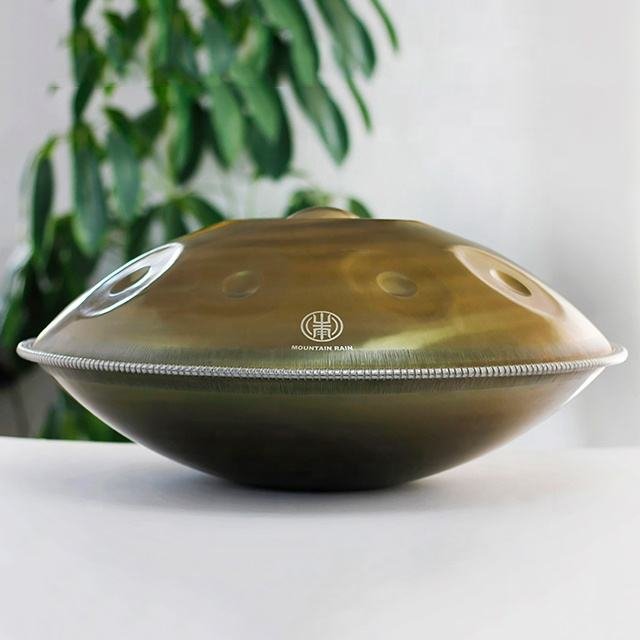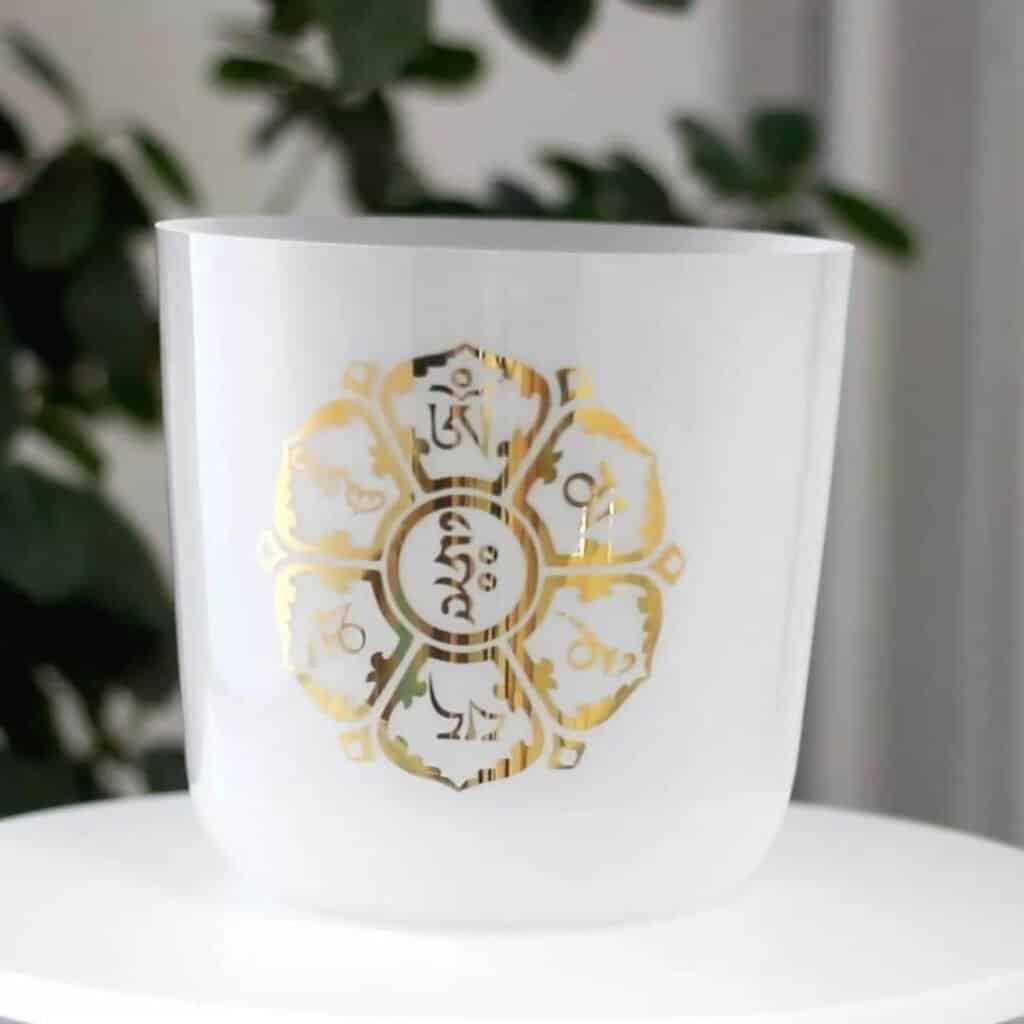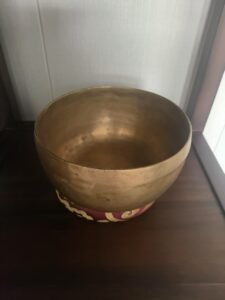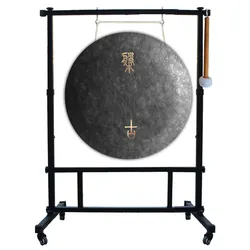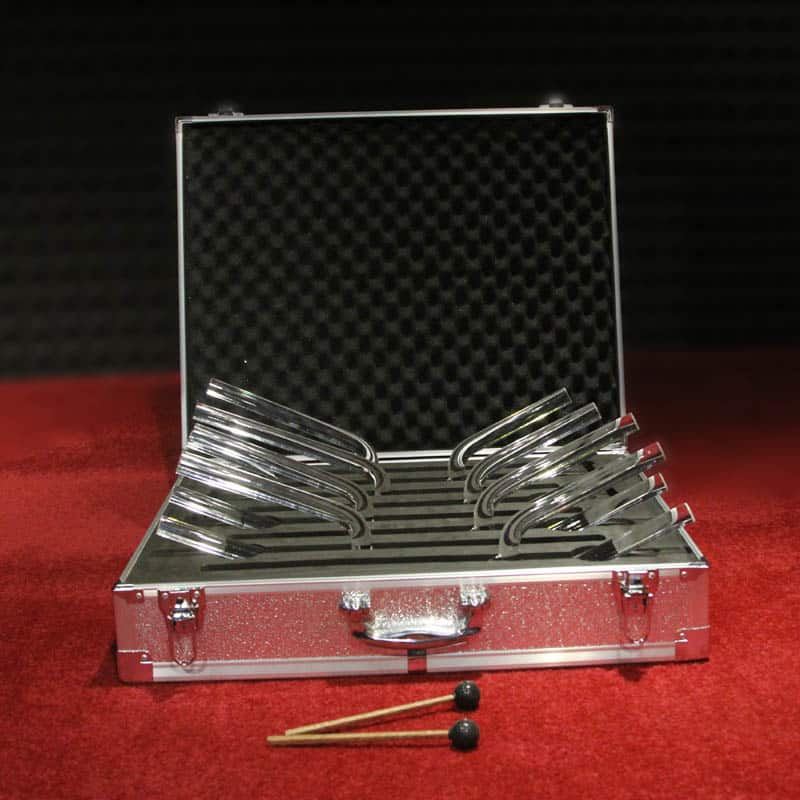Hollow crystal pyramids represent a fascinating category of musical instruments that combine ancient sacred geometry with modern sound healing practices. Unlike solid decorative crystal pyramids, these hollow instruments are specifically designed to produce resonant tones and therapeutic vibrations when struck or activated. The pyramid’s unique geometric shape creates distinctive acoustic properties that make these instruments particularly effective for meditation, sound therapy, and musical applications.
The growing popularity of crystal pyramid instruments in sound therapy and meditation music reflects their ability to produce pure, sustained tones that promote deep relaxation and healing. Professional sound therapists, meditation practitioners, and musicians increasingly recognize the unique qualities that crystal pyramids bring to both personal practice and therapeutic sessions. The hollow construction allows for rich resonance and complex harmonic overtones that create immersive sound experiences.
Crystal pyramid instruments differ fundamentally from their solid decorative counterparts in both construction and purpose. While solid crystal pyramids serve primarily as display pieces or energy tools, hollow crystal pyramids are engineered specifically for acoustic performance. The walls must be precisely crafted to specific thicknesses that optimize sound production, while the internal chamber creates the resonance space necessary for sustained, beautiful tones.
Understanding the unique acoustic properties of pyramid-shaped crystal instruments helps explain their effectiveness in healing and meditation applications. The geometric form naturally focuses and amplifies vibrations, while the crystal material provides exceptional clarity and sustain. This combination creates instruments capable of producing remarkably pure tones with extended resonance that can fill spaces with healing vibrations.
When selecting a crystal pyramid instrument, considerations extend far beyond aesthetic appeal to include acoustic performance, construction quality, and suitability for your intended applications. The size, crystal material, wall thickness, and craftsmanship all directly impact the instrument’s sound quality and musical capabilities. This comprehensive guide will help you navigate these factors to choose crystal pyramids that provide exceptional musical performance and lasting satisfaction.
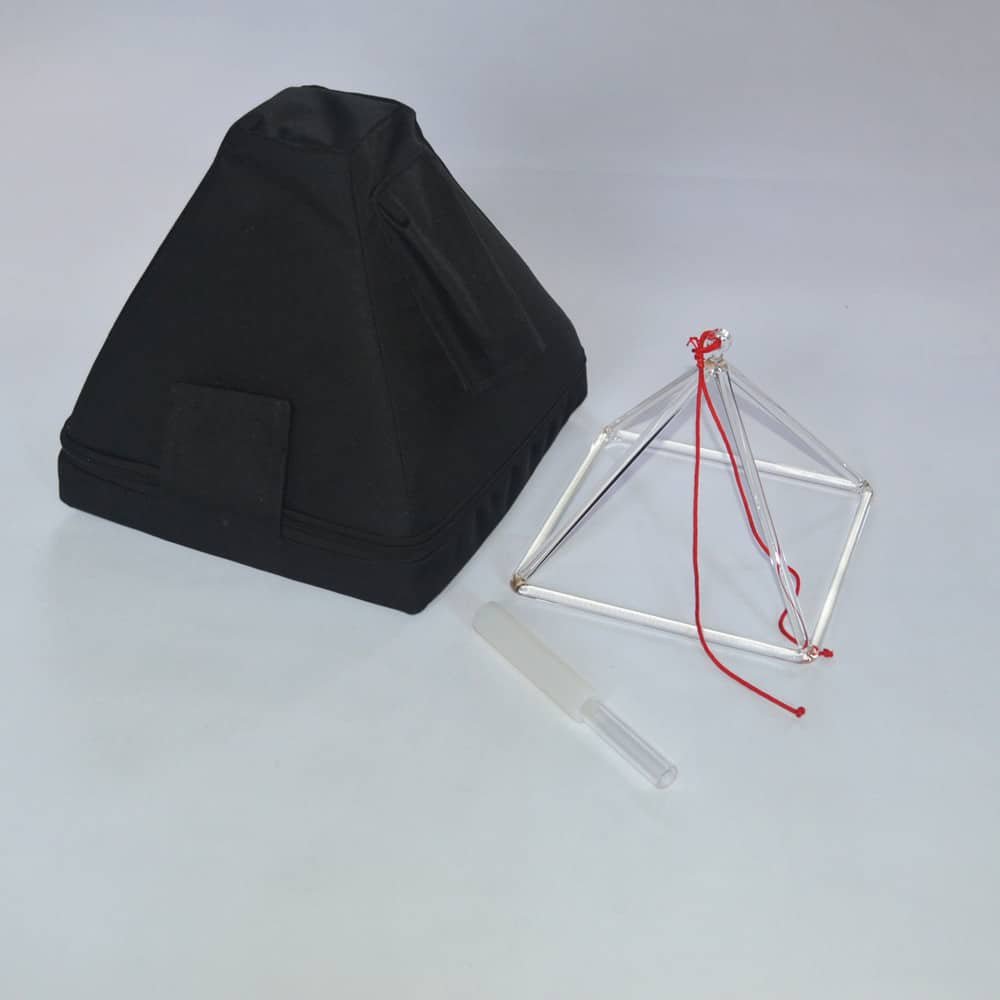
Sound Quality and Acoustic Properties
The acoustic performance of crystal pyramid instruments depends on multiple factors that work together to create their distinctive sound signature. Understanding these elements helps you evaluate different instruments and select pieces that meet your specific musical and therapeutic needs.
The pyramid shape creates unique acoustic properties that distinguish these instruments from other crystal sound tools. The converging walls focus vibrations toward the apex while the hollow chamber provides resonance space that amplifies and sustains the sound. This geometric design naturally enhances harmonic development and creates the complex overtone structures that make crystal pyramids so effective for meditation and healing work.
Frequency ranges vary significantly based on pyramid size, crystal material, and construction details. Smaller pyramids typically produce higher frequencies that create bright, penetrating tones excellent for focused attention work and mental clarity applications. These higher frequencies often carry well in group settings and can cut through ambient noise effectively.
Medium-sized pyramids usually offer balanced frequency ranges that provide versatility for various musical and therapeutic applications. The mid-range frequencies produced by these instruments work well for both personal meditation and professional therapy sessions, offering good projection while maintaining the gentle quality essential for relaxation work.
Large crystal pyramids generate lower frequencies that create profound, grounding effects particularly valuable for deep meditation and stress relief. The bass tones produced by substantial pyramid instruments can create physical sensations that enhance the meditative experience and promote deep states of calm and centeredness.
Sustain and resonance quality represent critical factors in evaluating crystal pyramid instruments. Premium instruments should maintain clear, beautiful tones for extended periods after initial activation, allowing for overlapping sounds and complex harmonic interactions. Poor-quality instruments may produce tones that fade quickly or become muddy and unclear during the sustain period.
Listen carefully to how the sound develops and evolves during the sustain cycle. Quality crystal pyramids often display changing harmonic content as the tone develops, with different overtones becoming prominent at various stages of the decay. This harmonic evolution adds musical interest and therapeutic value to the instrument’s performance.
Volume projection and acoustic presence determine how effectively crystal pyramids work in different environments and applications. Some instruments excel at intimate, close-range listening perfect for personal meditation, while others project powerfully enough for group sessions and larger spaces.
Consider the typical environments where you’ll use your crystal pyramid when evaluating projection characteristics. Therapy rooms, meditation studios, and home practice spaces each have different acoustic requirements that may favor specific volume and projection patterns.
Harmonic overtones and sound complexity distinguish exceptional crystal pyramids from basic instruments. Premium pieces produce rich harmonic content that creates depth and sophistication in the sound, while inferior instruments may sound thin or lacking in harmonic development.
When testing instruments, listen for the subtle harmonics that develop during the sustain period. These overtones contribute significantly to the meditative and therapeutic qualities of crystal pyramid instruments and often distinguish professional-grade pieces from hobbyist alternatives.
Testing sound quality before purchase provides the most reliable method for evaluating acoustic performance. Strike the pyramid gently with appropriate mallets or strikers and listen carefully to the immediate attack, sustain development, and decay characteristics. Quality instruments should produce clean, clear tones without harsh attacks or unwanted noise.
Pay attention to consistency across different striking locations and techniques. Well-constructed crystal pyramids should produce even, predictable responses regardless of where or how they’re activated, while poorly made instruments may have dead spots or inconsistent performance characteristics.
Room acoustics compatibility affects how crystal pyramid instruments sound in your intended performance or practice spaces. Hard surfaces tend to enhance resonance and projection, while soft furnishings and carpeting may absorb some frequencies and alter the overall tonal balance.
Consider recording yourself playing potential instruments in environments similar to your intended use spaces. This provides objective documentation of acoustic performance that helps compare different options and ensures your selected instrument works well in your specific acoustic environment.
Crystal Materials and Their Sonic Properties
Different crystal materials bring distinct acoustic characteristics to pyramid instruments, making the choice of crystal type as important as size and construction quality. Understanding how various crystals affect sound production helps you select instruments that align with your musical goals and therapeutic intentions.
Clear quartz pyramids offer exceptional versatility and represent the most popular choice for crystal pyramid instruments. Clear quartz provides pure, clean tones with excellent sustain and projection characteristics that work well across a wide range of applications. The neutral acoustic signature of clear quartz allows these instruments to blend harmoniously with other sound healing tools while maintaining their distinctive pyramid qualities.
The optical clarity of premium clear quartz also showcases the instrument’s construction quality and internal geometry, making any craftsmanship issues immediately apparent. This transparency helps verify that the hollow chamber is properly formed and that wall thickness remains consistent throughout the structure.
Clear quartz pyramids typically offer the longest sustain times and clearest harmonic development, making them excellent choices for meditation work where extended, pure tones support deep states of consciousness. The neutral energetic qualities of clear quartz also make these instruments suitable for practitioners who work with various healing modalities.
Colored crystal varieties introduce subtle but noticeable differences in acoustic performance alongside their visual appeal. The molecular structure differences that create color variations also affect how vibrations travel through the crystal material, resulting in distinct tonal characteristics for different crystal types.
Amethyst pyramids often produce slightly warmer, more complex tones than clear quartz, with enhanced harmonic content that many practitioners find particularly suitable for spiritual and meditative work. The purple coloration creates visually striking instruments that complement their distinctive acoustic properties.
Rose quartz pyramids typically generate softer, more gentle tones that work well for emotional healing and heart-centered practices. The pink crystal material seems to naturally produce nurturing sound qualities that support self-love work and relationship healing applications.
Citrine pyramids often create bright, energizing tones that complement the crystal’s association with abundance and manifestation work. The golden coloration produces visually warm instruments that match their uplifting acoustic characteristics.
Crystal thickness and wall density significantly impact both the acoustic performance and structural integrity of pyramid instruments. Thicker walls generally produce deeper, more resonant tones with enhanced sustain, while thinner walls may create brighter, more delicate sounds with quicker decay.
The relationship between wall thickness and crystal size determines optimal proportions for different acoustic goals. Larger pyramids can accommodate thicker walls that enhance their naturally lower frequency ranges, while smaller instruments may require thinner walls to maintain proper acoustic response.
Consistent wall thickness throughout the pyramid structure ensures even acoustic performance and prevents weak spots that could affect both sound quality and structural durability. Premium instruments maintain precise thickness tolerances that support optimal acoustic performance.
How crystal quality affects acoustic performance extends beyond basic material selection to include factors like internal clarity, molecular consistency, and freedom from stress fractures or inclusions that might dampen vibrations.
High-grade crystal materials transmit vibrations more efficiently and maintain harmonic clarity throughout extended sustain periods. Lower-quality crystals may introduce distortions or limit sustain time due to internal inconsistencies that interfere with clean vibration transmission.
Visual inspection can reveal many quality factors that correlate with acoustic performance. Clear, consistent crystal with minimal inclusions typically produces better sound than cloudy or heavily included material, though some natural variations may not significantly impact acoustic performance.
Frosted versus clear crystal surfaces create noticeable differences in both acoustic performance and visual appeal. Frosted surfaces often produce slightly softer, more diffused tones that some practitioners prefer for gentle meditation work, while clear surfaces typically offer brighter, more projecting sound characteristics.
The surface treatment also affects how light interacts with the instrument, influencing the visual component of sound healing sessions. Clear crystal pyramids create beautiful light effects that enhance the overall sensory experience, while frosted surfaces provide more subtle visual appeal.
Matching crystal type to musical applications requires considering both the acoustic properties and energetic qualities associated with different crystal materials. Practitioners who emphasize the therapeutic aspects of crystal pyramid work often choose materials based on their traditional metaphysical properties, while musicians may prioritize purely acoustic considerations.
Many professionals find value in maintaining collections of crystal pyramids in different materials, allowing them to select the most appropriate instrument for specific sessions or client needs. This approach provides maximum flexibility while supporting exploration of how different crystal energies interact with pyramid acoustics.
Size and Tuning Considerations
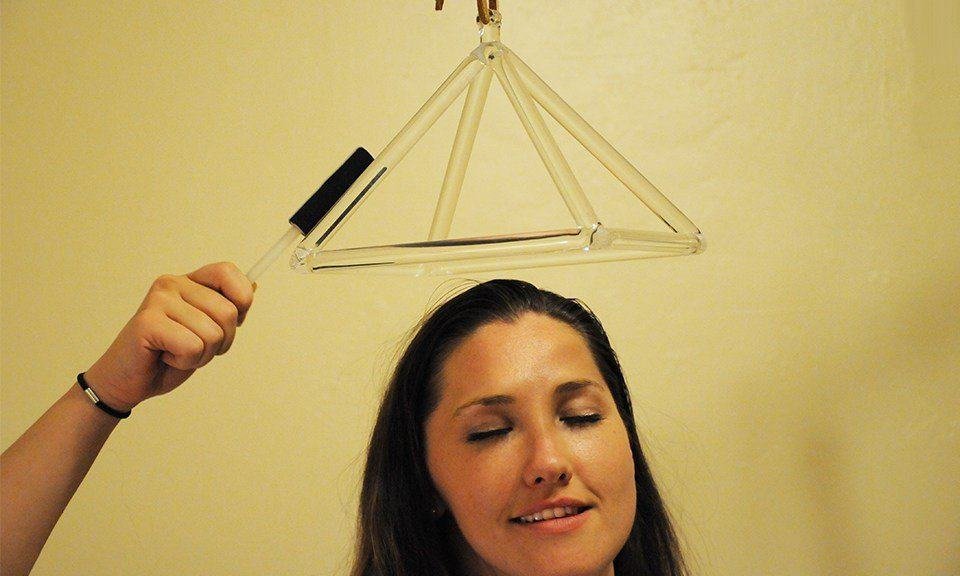
The size of crystal pyramid instruments directly determines their fundamental frequency range and acoustic capabilities, making size selection crucial for achieving desired musical and therapeutic outcomes. Understanding how dimensions affect sound production helps you choose instruments that serve your specific applications effectively.
Small crystal pyramids, typically measuring 2 to 4 inches at the base, produce higher frequencies that create bright, penetrating tones excellent for mental clarity work and focused attention practices. These compact instruments generate frequencies that naturally draw attention and can effectively cut through ambient noise in group settings or challenging acoustic environments.
The higher pitch ranges of small pyramids make them particularly suitable for work involving the upper chakras, mental healing, and spiritual connection practices. The bright, clear tones help promote alertness and mental focus while maintaining the calming qualities essential for meditation work.
Small pyramids also offer practical advantages in terms of portability and storage, making them ideal for practitioners who travel frequently or work in multiple locations. Their compact size allows for easy transport and setup while providing sufficient acoustic power for personal and small group applications.
However, the higher frequencies of small pyramids may lack the grounding qualities that some practitioners prefer for deep relaxation work. Consider your primary applications when evaluating whether small pyramid frequencies align with your therapeutic goals.
Medium crystal pyramids, ranging from 4 to 8 inches, provide balanced tonal ranges that offer versatility across various musical and therapeutic applications. These instruments typically produce mid-range frequencies that feel neither too stimulating nor too grounding, making them excellent choices for general meditation and sound therapy work.
The balanced frequency range of medium pyramids works well for both personal practice and professional therapy sessions, offering good projection characteristics while maintaining the gentle quality needed for relaxation and healing work. This versatility makes medium-sized pyramids popular choices for practitioners who need instruments suitable for diverse applications.
Medium pyramids often provide the best combination of acoustic presence and practical manageability, offering substantial sound production while remaining easy to position, transport, and integrate into various practice settings.
Large crystal pyramids, measuring 8 inches or more at the base, generate deep, resonant frequencies that create profound grounding effects particularly valuable for stress relief and deep meditation work. The lower frequency ranges produced by substantial pyramid instruments can create physical sensations that enhance the meditative experience.
Large pyramids excel in applications requiring powerful acoustic presence and extended sustain times. Their substantial mass and volume create impressive sound projection that can effectively fill large spaces and support group meditation or therapy sessions.
The deep tones of large pyramids often resonate strongly with the lower chakras and physical body, making them valuable tools for grounding work and physical healing applications. However, their size and weight create practical challenges for transport and positioning that must be considered.
Tuning accuracy and pitch stability become increasingly important as you develop more sophisticated musical applications for crystal pyramid instruments. Quality instruments should maintain consistent pitch relationships and stable tuning under varying environmental conditions.
Some manufacturers tune their crystal pyramids to specific musical notes or frequencies that align with traditional healing or musical systems. Understanding these tuning relationships helps you select instruments that work harmoniously together and with other musical elements in your practice.
Pitch stability depends on factors including crystal quality, construction consistency, and environmental conditions. Temperature and humidity changes can affect tuning slightly, though quality crystal instruments typically maintain better stability than many other acoustic instruments.
Creating sets with harmonic relationships allows you to build collections of crystal pyramids that work together musically and therapeutically. Instruments tuned to complementary intervals create beautiful harmonic interactions when played together, enhancing both the acoustic and energetic effects of your sound work.
Consider mathematical relationships like octaves, perfect fifths, and other traditional harmonic intervals when selecting multiple pyramid instruments. These relationships create natural consonance that supports both musical expression and therapeutic effectiveness.
Document the tuning and acoustic characteristics of your pyramid instruments to help plan effective combinations and track any changes over time. This information proves valuable for both musical applications and maintaining optimal performance from your instrument collection.
Construction Quality and Durability
The construction quality of crystal pyramid instruments directly impacts both their acoustic performance and long-term durability, making careful evaluation of craftsmanship essential for wise purchasing decisions. Understanding quality indicators helps you distinguish between professional-grade instruments and inferior alternatives that may disappoint in performance or longevity.
Evaluating hollow chamber construction integrity requires examining how the internal space is formed and maintained within the crystal structure. Premium pyramid instruments feature precisely engineered chambers with consistent dimensions and smooth internal surfaces that optimize acoustic resonance.
Look for evidence of uniform wall thickness throughout the pyramid structure, as variations can create acoustic inconsistencies and potential structural weak points. Quality construction maintains precise tolerances that ensure even vibration transmission and optimal sound production.
The method used to create the hollow chamber affects both acoustic properties and structural integrity. Hand-hollowed pyramids often display superior craftsmanship and attention to detail, while machine-hollowed pieces may offer more consistent dimensions but potentially less character in the acoustic response.
Inspect the chamber opening for clean, precise edges and proper proportions relative to the overall pyramid size. The opening should be large enough to allow proper resonance while maintaining the structural integrity needed for safe handling and long-term use.
Wall thickness consistency plays a crucial role in both acoustic performance and structural durability. Optimal thickness varies with pyramid size and crystal material, but consistency throughout the structure remains essential for even sound production and structural reliability.
Use backlighting or other inspection methods to evaluate wall thickness uniformity when possible. Significant variations may indicate poor craftsmanship or manufacturing defects that could affect both sound quality and durability.
Consider how wall thickness relates to the intended use of your pyramid instrument. Thicker walls generally provide better durability for frequent handling but may affect acoustic response, while thinner walls might offer superior sound characteristics at the cost of increased fragility.
Joint quality and structural soundness become particularly important for pyramid instruments that will experience regular handling and potential transport. Examine all edges and junction points for clean, precise construction without gaps, rough areas, or signs of structural weakness.
Test the overall stability and balance of pyramid instruments to ensure they sit securely when placed on flat surfaces. Poor proportions or construction irregularities may create instability that affects both usability and safety during performance.
Check for any existing chips, cracks, or stress points that might indicate fragility or previous damage. These issues can significantly impact both acoustic performance and structural reliability, potentially leading to further damage with use.
Surface finish effects on sound production extend beyond aesthetic considerations to include factors that influence vibration transmission and acoustic clarity. Smooth, evenly polished surfaces typically provide optimal acoustic performance, while rough or inconsistent finishes may dampen vibrations or create unwanted noise.
Examine all external surfaces for consistent polish and freedom from scratches, tool marks, or other irregularities that might affect both appearance and acoustic performance. Quality finishing should enhance rather than detract from the crystal’s natural beauty and acoustic properties.
The surface finish also affects maintenance requirements and long-term appearance, with higher-quality finishes typically requiring less care and maintaining their beauty longer under regular use conditions.
Identifying manufacturing defects requires systematic inspection of both visible features and acoustic performance characteristics. Common defects include uneven wall thickness, poor chamber construction, surface irregularities, and structural weaknesses that may not be immediately apparent.
Test acoustic performance thoroughly, listening for any unusual sounds, inconsistent response, or acoustic anomalies that might indicate internal defects or construction problems. Quality instruments should produce clean, predictable sounds without unwanted noise or irregular behavior.
Document any concerns or questions about construction quality before finalizing your purchase, and don’t hesitate to request additional information or alternative pieces if quality issues are apparent.
Durability for regular musical use depends on both material properties and construction quality, with factors like crystal hardness, wall thickness, and overall design contributing to long-term reliability under performance conditions.
Consider your intended use patterns when evaluating durability requirements. Instruments used primarily for gentle meditation work may not need the same ruggedness as pieces intended for active musical performance or frequent transport.
Research the track record of different manufacturers or sources regarding durability and customer satisfaction, as this information can provide valuable insights into long-term reliability expectations for different quality levels and price points.
Playing Techniques and Musical Applications
Understanding proper playing techniques and musical applications helps you maximize the potential of crystal pyramid instruments while ensuring safe, effective use that produces beautiful sounds and supports your intended therapeutic or artistic goals.
Basic striking and activation methods form the foundation of crystal pyramid performance technique. Use appropriate mallets or strikers designed for crystal instruments, avoiding hard materials that might damage the crystal surface or produce harsh, unmusical sounds.
Soft rubber mallets often work well for gentle activation that produces warm, sustained tones suitable for meditation and relaxation work. Harder mallets may create brighter, more penetrating sounds appropriate for attention-focusing applications or musical performances requiring greater projection.
Experiment with striking different areas of the pyramid to discover variations in tone and response. Many pyramid instruments produce slightly different characteristics when struck near the base versus higher on the walls, allowing for subtle musical expression and tonal variety.
The striking force significantly affects both the initial attack and sustain characteristics of crystal pyramid tones. Gentle strikes typically produce softer, more gradual sound development that feels less intrusive and more supportive of meditative states, while firmer activation creates more immediate presence and projection.
Creating sustained tones and vibrations involves techniques that maximize the natural resonance capabilities of crystal pyramid instruments. Allow each tone to develop fully before adding new sounds, listening to how the harmonic content evolves during the sustain period.
Practice breath coordination with your playing, using the natural rhythm of breathing to guide timing and pacing. This coordination enhances the meditative qualities of pyramid playing while creating natural musical phrasing that feels organic and supportive.
Experiment with techniques that extend sustain time, such as gentle re-striking before tones fade completely or using multiple pyramids to create overlapping sound layers that maintain continuous acoustic presence.
Combining multiple pyramids for layered sounds opens up sophisticated musical possibilities that enhance both artistic expression and therapeutic effectiveness. Start with simple two-pyramid combinations before progressing to more complex arrangements involving multiple instruments.
Consider the harmonic relationships between different pyramid instruments when creating layered sounds. Instruments tuned to complementary intervals create natural consonance that supports both musical beauty and therapeutic goals.
Practice timing techniques that create smooth sound transitions and avoid acoustic conflicts between different instruments. Skillful layering requires sensitivity to how different tones interact and influence each other in the acoustic environment.
Integration with other crystal instruments expands the musical and therapeutic possibilities of pyramid playing while requiring understanding of how different crystal instruments complement each other acoustically and energetically.
Crystal bowls, harps, and other crystal instruments often work beautifully with pyramid sounds, creating rich acoustic environments that enhance meditation and healing experiences. Experiment with different combinations to discover partnerships that feel musically and energetically harmonious.
Consider the frequency ranges and acoustic characteristics of different crystal instruments when planning integrated performances. Instruments with complementary frequency ranges and similar sustain characteristics often work together more successfully than those with conflicting acoustic properties.
Meditation and sound therapy applications represent primary uses for crystal pyramid instruments, requiring sensitivity to how musical elements support rather than distract from therapeutic goals. The pacing, volume, and musical content should enhance relaxation and focus rather than demanding attention or creating stimulation.
Develop sensitivity to the appropriate volume levels for different therapeutic applications and client needs. What feels supportive and enhancing for one person might feel overwhelming or insufficient for another, requiring flexibility and responsiveness in your playing approach.
Consider the emotional and energetic arc of therapy sessions when planning musical support, using pyramid sounds to help establish focus, maintain therapeutic presence, and support transitions between different phases of the healing work.
Performance and recording considerations involve technical factors that affect how crystal pyramid sounds translate in different acoustic environments and reproduction systems. Live performance requires understanding of projection, room acoustics, and audience interaction with pyramid sounds.
Recording crystal pyramids effectively often requires specific microphone techniques and acoustic environments that capture both the direct sound and natural resonance characteristics. Experiment with different recording approaches to find methods that preserve the essential qualities of your pyramid instruments.
Consider how crystal pyramid sounds interact with other instruments or voices in performance contexts, balancing the distinctive qualities of pyramid tones with overall musical coherence and effectiveness.
Where to Buy and Quality Assurance
Finding reliable sources for crystal pyramid instruments requires identifying dealers who understand the specific requirements of musical applications and can provide instruments that meet acoustic performance standards rather than just aesthetic appeal.
Specialized crystal instrument dealers typically offer the best selection and expertise for serious musical and therapeutic applications. These suppliers understand the distinction between decorative crystal pyramids and functional musical instruments, providing appropriate options with verified acoustic performance.
Look for dealers who can demonstrate their instruments’ acoustic properties and provide detailed information about construction methods, crystal materials, and performance characteristics. Knowledgeable suppliers often maintain relationships with skilled craftspeople and can provide insights about quality factors and performance expectations.
Research dealer specializations and customer feedback to identify sources that consistently provide quality instruments suitable for serious musical and therapeutic work. Established dealers often maintain reputations that reflect their commitment to customer satisfaction and product quality.
Testing instruments before purchase provides the most reliable method for evaluating acoustic performance and ensuring that your selected pyramid meets your specific requirements. When possible, arrange to audition potential instruments in environments similar to your intended use conditions.
Pay attention to how instruments respond under different playing techniques and listen carefully for consistency, clarity, and acoustic character that aligns with your musical and therapeutic goals. Trust your ears and intuitive response to different instruments, as these often provide valuable guidance beyond technical specifications.
If in-person testing isn’t possible, request audio recordings or video demonstrations that showcase the acoustic characteristics of specific instruments. While recordings can’t fully capture all acoustic nuances, they provide valuable information about basic sound quality and performance characteristics.
Understanding sound quality guarantees helps protect your investment while ensuring access to instruments that meet professional performance standards. Quality-focused dealers often provide return periods or exchange options that allow evaluation under actual use conditions.
Clarify warranty coverage for acoustic performance issues, structural defects, and other quality concerns that might affect your satisfaction with purchased instruments. Comprehensive guarantees demonstrate dealer confidence in their products while protecting customers from disappointing purchases.
Document any specific acoustic requirements or quality expectations before purchase, ensuring that both you and the dealer understand the performance standards your selected instrument should meet.
Avoiding decorative pyramids mismarketed as instruments requires understanding the fundamental differences between aesthetic pieces and functional musical tools. Decorative pyramids may look beautiful but lack the hollow construction and acoustic engineering needed for musical applications.
Be cautious of sellers who cannot provide specific information about acoustic properties, construction methods, or performance characteristics of their pyramid offerings. Vague descriptions or focus solely on metaphysical properties rather than acoustic performance may indicate decorative rather than musical instruments.
Research product descriptions carefully, looking for specific mentions of hollow construction, acoustic testing, and musical applications. Legitimate musical instruments should be marketed with emphasis on their sound production capabilities rather than only aesthetic or decorative features.
Building relationships with knowledgeable suppliers creates long-term advantages including access to new inventory, expert guidance in instrument selection, and ongoing support for maintenance and care questions.
Experienced suppliers often provide valuable education about playing techniques, care requirements, and optimal applications for different types of crystal pyramid instruments. This expertise proves particularly valuable for practitioners developing their skills and expanding their instrument collections.
Consider supporting suppliers who demonstrate genuine expertise and commitment to the crystal instrument community, as these relationships often provide access to exceptional pieces and specialized knowledge that enhances your musical and therapeutic practice.
Maintenance and care requirements for crystal pyramid instruments include regular cleaning, careful handling, and appropriate storage that protects both acoustic performance and structural integrity. Develop consistent care routines that preserve your investment while ensuring optimal performance over time.
Conclusion
Choosing the right crystal pyramid instrument involves balancing acoustic performance, construction quality, and practical considerations that align with your specific musical and therapeutic goals. The hollow construction, crystal material, size, and craftsmanship all contribute to creating instruments capable of producing the pure, sustained tones that make crystal pyramids so effective for meditation and sound healing work.
Remember that sound quality should take priority over appearance when selecting musical instruments, as the acoustic performance determines the effectiveness of your pyramid for meditation, therapy, and musical applications. Take time to evaluate different options thoroughly, testing acoustic characteristics and construction quality to ensure lasting satisfaction with your choice.
Your crystal pyramid instrument will become a valuable tool in your sound healing practice, capable of producing beautiful tones that support meditation, enhance therapeutic work, and provide musical expression opportunities. Choose wisely by prioritizing quality construction and acoustic excellence, and your pyramid will serve you faithfully for many years of meaningful practice.
Whether you’re acquiring your first crystal pyramid or expanding an existing collection, focus on finding instruments that resonate with both your musical sensibilities and therapeutic intentions. The right crystal pyramid awaits, ready to become a treasured ally in your journey of sound healing and musical meditation.
Begin your search with clear intentions about your needs and applications, but remain open to discoveries that might lead you toward instruments that exceed your expectations. Your perfect crystal pyramid instrument is out there, waiting to enhance your practice with its unique combination of sacred geometry and crystal acoustics.


